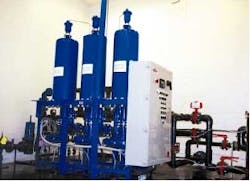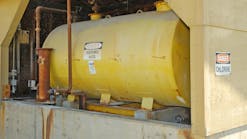Click here to enlarge imageHigh levels of iron and manganese can create problems for both the water utility's distribution system and customers' plumbing and water quality. Although not toxic at the levels normally found in water supplies, iron and manganese can contaminate well water sources to varying degrees. The problem is not simply a matter of concentration; it depends partly on the chemical form in which the metals exist. In well waters, these contaminants are normally found as soluble salts.
Depending on the nature and degree of the contamination, the IronMan system uses various oxidation techniques to convert the soluble metals to an insoluble form. For example, when manganese occurs as an unbound inorganic salt, it can readily be oxidized and precipitated from solution. At higher concentrations, oxidation can be achieved by dosing the water with potassium permanganate. At lower levels, other methods may be selected.
The choice of oxidant used in the IronMan system will depend on site specific considerations, including concentration of iron, the presence or absence of manganese, water temperature and water pH. Consideration also must be given to the potential for formation of chlorinated hydrocarbons, and so the use of chlorine may be limited in certain cases.
Once the oxidation phase is complete, the precipitated manganese can then be removed from the water by filtration, using the Fibrotex filter. Whereas conventional depth filters have a high solids-holding capacity and are usually backwashable, they suffer from the disadvantage of having a relatively coarse nominal filter rating. Cartridge filters, on the other hand, have a fine filtration rating but have a low solids capacity and are generally not self-cleaning.
The IronMan Fibrotex system represents a combination of both types of filter in that it is an automatic backwashable depth filter with a higher solids capacity and a fine filtration rating.
A key feature of the technology is the marriage of an expandable-bed fibrous filter element with a Programmable Logic Control (PLC) system. It is this coupling of technologies that enables the filter both to backwash itself automatically when fully loaded with solids, and to achieve exceptionally fine levels of filtration.
The configuration of the element is governed by rotational and vertical air motors driven by the PLC. In the filtration mode, the PLC directs the control motors to wind and compress the fibers into a tight coil capable of capturing particulates from the inward-flowing feedstream; clarified filtrate leaves the element via the central core.
Yarn comprises the fibrous filter element. The most widely used materials are nylon or polyester. Acrylic polymers are also used in certain cases. Each strand of the material used to make the element consists of many fine, crimped fibers. The strands are cross-woven at the ends to form a cloth, and the filter element is made by winding the cloth around the endplates of the central spring to which it is then sealed. In the filtration mode, the strands of yarn are packed together, eliminating the spaces between them, to form an effective filter medium. Particles are captured in the crimped fibrous network within the strands of yarn.
Once the element is fully saturated with solids, the system automatically comes off-line and enters the backwash cycle. Backwashing can be triggered after a preset time interval, when the pressure differential rises to a critical level, or by the quality of the filtrate. The PLC commands the motors to uncoil and stretch the fibers, which are then twisted alternately clockwise and counter-clockwise in a wringing action as the particles are flushed outwards by the backwash water.
The expulsion of the particles depends primarily on the mechanical action of the element during backwashing. Alternate tensioning and relaxation of the crimped fibers causes particulates to be displaced during the self-cleaning process. Backwash water acts as a carrier to remove the displaced particulates rather than as the primary cleaning agent as in other backwashable depth filters. As a result, backwashing is highly efficient and requires a low volume of backwash water. Backwash rates are typically less than 2% of the filtrate and last only for a few minutes.
A single filter unit can handle flow rates up to 125 gpm from well water sources. Multiple units can be configured in parallel for higher flow rates. Employing multiple units allows for continual flow and operation 24 hours a day with standby capacity available - even during backwash cycles.
The Fibrotex filter system features a small footprint. Generally, they require only 25% of the floor space of a comparable multi-media filter. This is particularly suited for small to medium-sized communities that have space concerns at existing water utilities.



